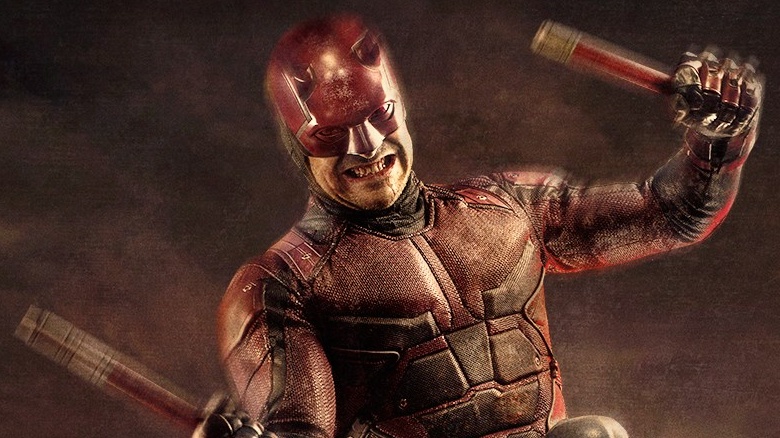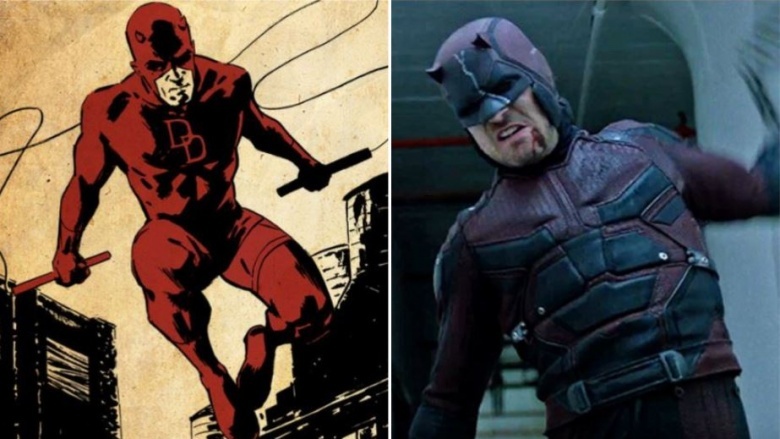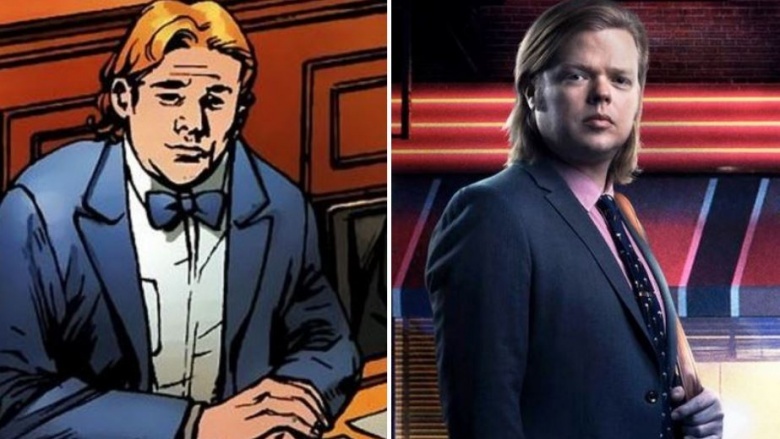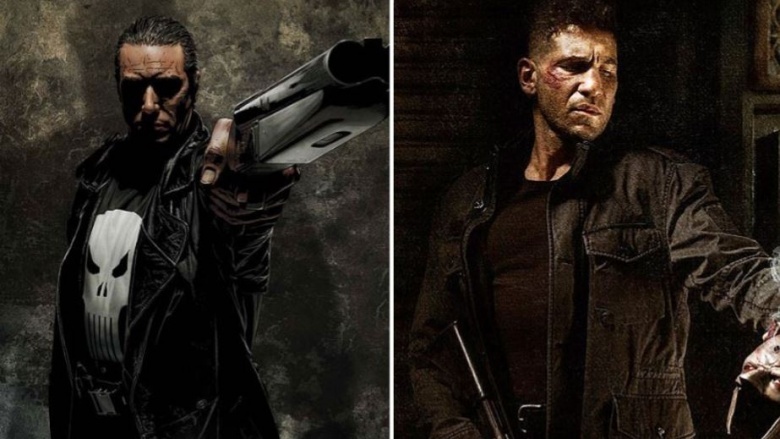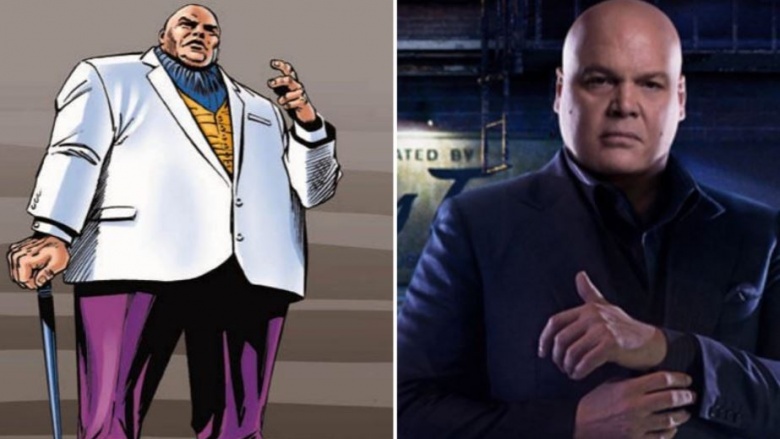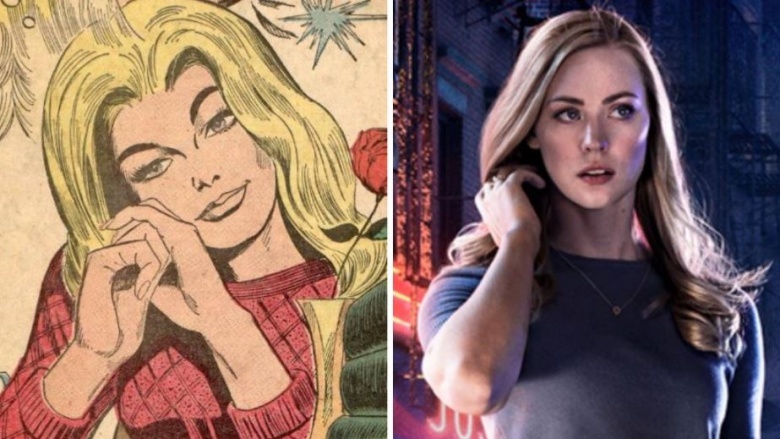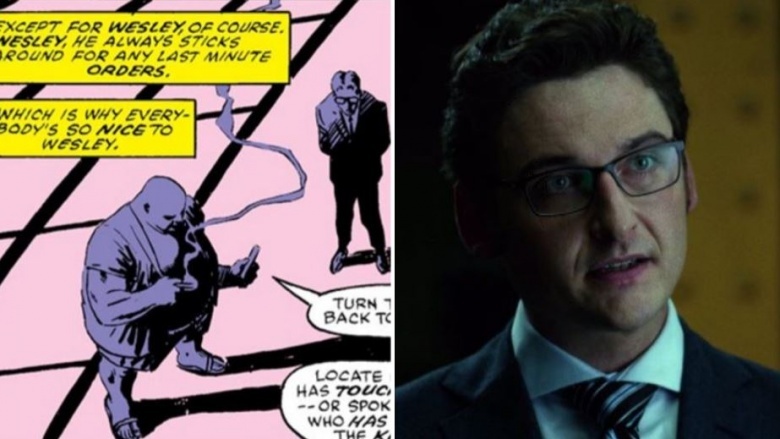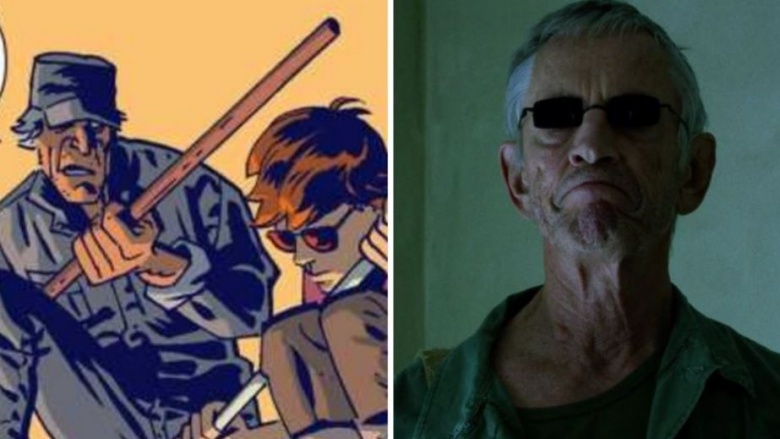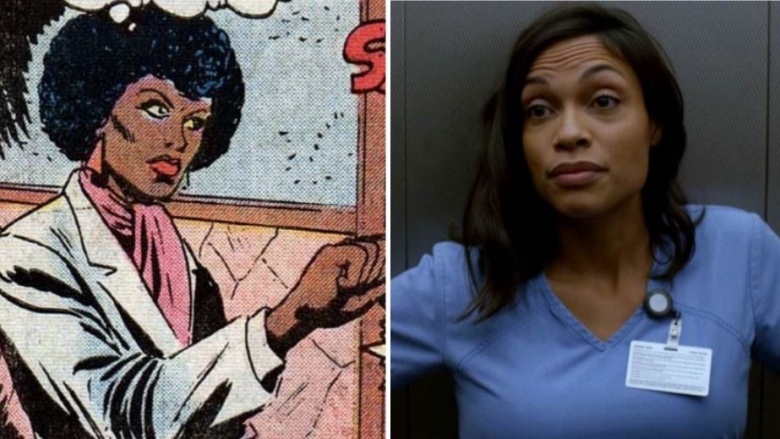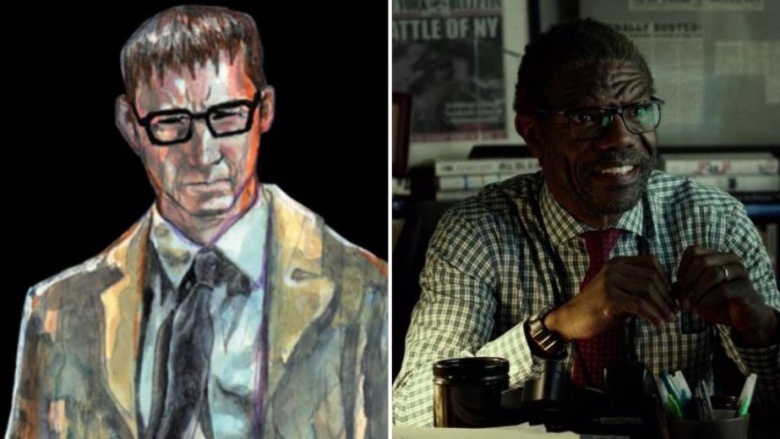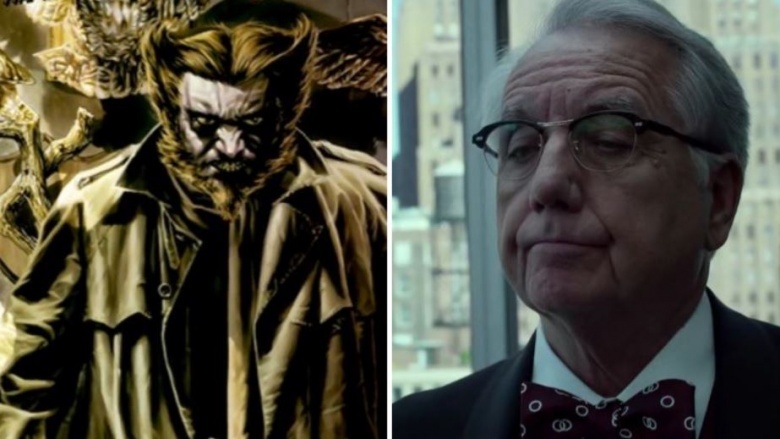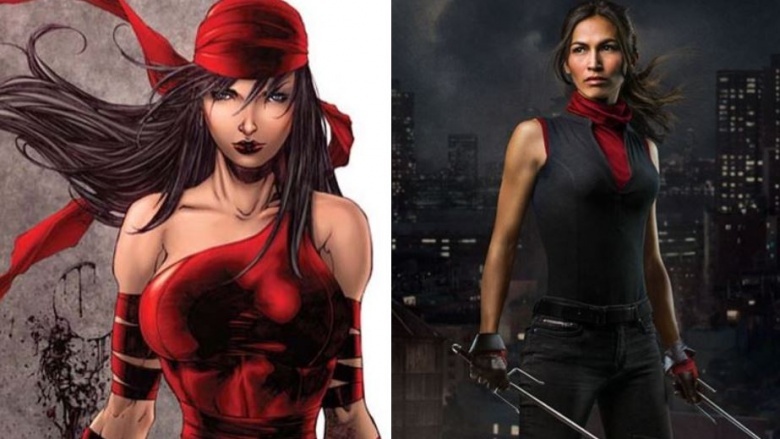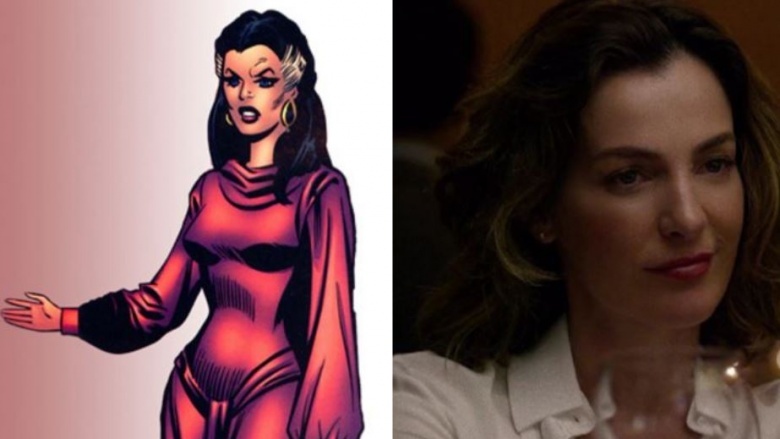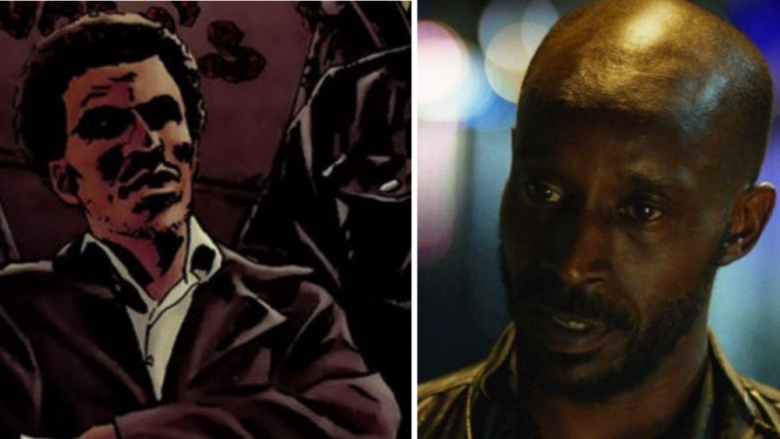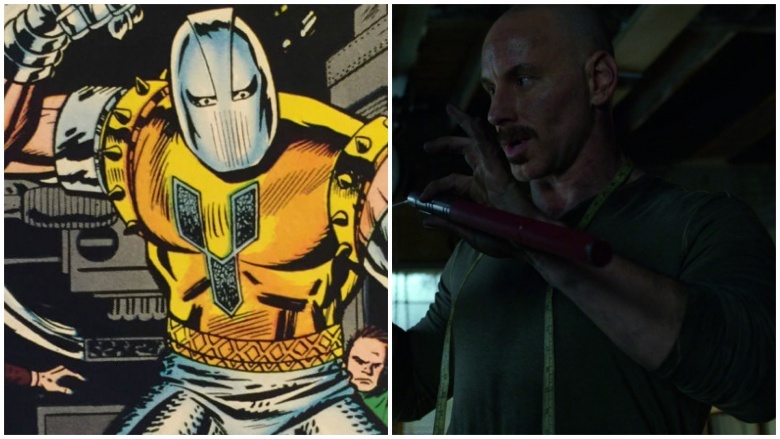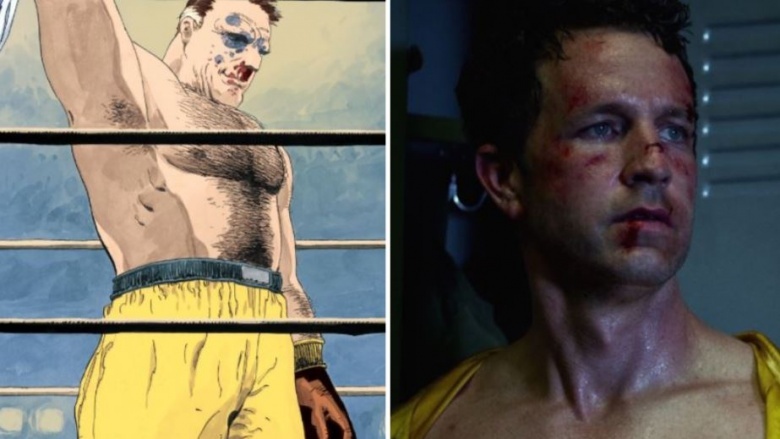How The Cast Of Daredevil Should Really Look
Marvel's Daredevil series on Netflix remains pretty faithful to the source material. But in keeping true to its goal of telling a more grounded superhero story, some characters needed to not look so ridiculous. Brightly-colored spandex and elaborate theatrical getups don't scream "grounded urban crime drama." Yet, remarkably, some characters have remained largely the same. What are the differences? Take a look for yourself as we show you how the cast of Daredevil should really look according to the comics.
Daredevil
TV's Daredevil is a quintessential example of what happens when a comic book superhero is confronted with their worst enemy: real-world aesthetics. If his costume were modeled exactly off the comics, it would look more like Spider-Man's formfitting onesie than the sleek tactical suit of armor he wears on the show. In the comics there isn't even the vaguest suggestion of armor lining the suit—he's all muscles and sinew wrapped in a strawberry-flavored Fruit Roll-Up. The suit on Netflix is segmented—pants, top, helmet—and, of course, is missing the signature doubled Ds on the chest. Superhero branding has no place in Marvel's gritty Netflix universe.
Franklin 'Foggy' Nelson
Foggy's look translates well onto the screen. It's not like it's difficult to put someone in a suit and tie and give their hair a little length, but if there's one difference between the page and screen versions, it's the bowtie, which has been part of his signature look in the comics for decades. The change does make sense, considering how Foggy's personality has changed between the comics and the show. Traditionally, in the comics, Foggy is a nervous and lovable sidekick who's riddled with nerves and fears. Since Matt Murdock is a confident lawyer by day and a crimefighter by night, Foggy balances out the pairing by being absolutely none of that. He has a personality befitting someone who wears a bowtie on a daily basis. On the show, Foggy isn't as much of a pushover; in fact, he pushes back quite a bit. He's tough, he's got a spine, and is not afraid to stand up to anybody, including Matt. Therefore, he gets a good old-fashioned tie.
The Punisher
It's kind of hard to mess up the Punisher—just dress the guy in a black T-shirt and a black jacket and hand him a gun. Luckily, Jon Bernthal not only looks the part, but does a spectacular job of bringing to life a damaged soldier mentally spiraling downward in the wake of immense tragedy. Dress anybody in a skull shirt and leather and then tell them to be a gun-happy vigilante, and they can pass for a decent Frank Castle. You probably went to high school with least five people who dressed that way as a part of their normal, everyday routine. But to able to make that person feel like a genuine human being, and to make viewers understand his pain even if they don't agree with his actions? That's much harder to pull off.
The Kingpin, a.k.a. Wilson Fisk
There's a reason Kingpin's traditional purple pants and white jacket never made it beyond a quick reference in the first season of Daredevil. It works well on the page, and maybe would've worked on TV during the '70s or the '80s, but the only time people wear white jackets in the 21st century is to a wedding, or maybe if you're a waiter at a fine restaurant. The ascot around his neck also seems to be a relic of a fashion sensibility for the upper crust of society that didn't make it into the new millennium. In its place around Vincent D'Onofrio's neck is...nothing. Not even a tie. Instead, TV's Kingpin wears the finest suits. Then again, he could be wearing clown shoes, boxer shorts, and a tank top, and he would still look like Kingpin. There isn't an actor on Earth who'd look better in the role. Netflix and Marvel must thank their lucky stars every day for the gift that is D'Onofrio.
Karen Page
There isn't much difference between the TV and comic book versions of Karen Page. In fact, there's no difference: she's a blonde white girl on the page and she's a blonde white girl on the screen. They really didn't have to do too much prep for this one. No long makeup sessions or prosthetic fitting sessions. No elaborate costumes. Karen Page is a blonde woman. Done.
James Wesley
James Wesley, who goes simply by the name Wesley in the comics, features prominently in the first season of Daredevil. He plays a pretty large role as Kingpin's right-hand man and doer of dirty deeds, and he plays a similar role in the comics. Much like the Wesley you saw on Netflix, comics Wesley didn't have an enduring presence. He only showed up in a handful of Daredevil issues in the '80s and pretty much disappeared after that. The image you see above of a bespectacled man in a suit with hardly any detail in his face is the only image of Wesley online. Outside of Karen Page, translating Wesley to screen must've been one of the easier adaptations for the costume department to pull off.
Stick
When you're dealing with Stick, there are only a couple of things to keep in mind. One, he's a disheveled old blind guy. Two, he looks like a Vietnam vet who might work as a high school janitor. Every version of the character, live-action or illustrated, hews to that exact look. If we were to tell you that of the other end of that stick on the left was a mop head you'd believe it, just as you'd believe that Stick's expression on the right is in response to a particularly gnarly toilet clog in the girls' bathroom.
Claire
Claire's a character whose visual style changes with the times. When she was created in 1972 she had an Afro, and in the '80s her hair was long and curly. Claire of today looks more like the version played by Rosario Dawson in the Netflix Defenderverse. She will always match the era she's in, but there's one thing that remains constant, no matter the decade: She will always be an overworked and underappreciated nurse.
Ben Urich
Outside of skin tone, the biggest shift in the visual stylings of the Marvel Universe's best reporter is that his portrayal in Daredevil had way too much inherent coolness. For years, the Ben Urich of the comics was simultaneously a hard-hitting, hard edged, chain-smoking investigative journalist who wasn't afraid to get himself involved with some dirty people, and yet, he never seemed like he fit in with that world. He's always been a bit of a dweeb—kind of a mousy, unassuming guy who just so happens to be unafraid to dive headfirst into the dark underbelly of New York crime. Oh, and the Ben Urich on the show wore entirely too much plaid.
Leland Owlsley, a.k.a. The Owl
Leland Owsley underwent arguably the biggest comics-to-screen change of any Daredevil character. In terms of personality, they're somewhat similar, both being financiers of criminal enterprises. But beyond that they differ wildly, as you can see in the picture above. Netflix's Leland is a bespectacled and bow-tied walking suit. Comic book Leland, or the Owl as he's better known, looks so much like Wolverine that you realize Wolverine's name should have been the Owl. Older versions of the character look a lot more whimsical. He sported a green Ulster coat, kind of like the one a Victorian era Sherlock Holmes is usually depicted as wearing. In some versions he wore a big ridiculous red bowtie around his neck that made his head look like an extravagantly wrapped Christmas gift.
Elektra Natchios
The problem with comic book Elektra is that no self-respecting female warrior would be caught dead fighting in what amounts to a skintight swimsuit. And Elektra, for some reason, is usually drawn covered in so many wafting scarves that she looks like Steven Tyler's microphone stand. She's the very definition of an impractically dressed assassin—she never even has a place to put her sais. That's why she's always holding them. Give the poor woman a holster or something, at least.
Vanessa Marianna
In the comics, Kingpin's beloved Vanessa has a weird thing for robes. On TV, however, she dresses the way you'd expect a woman of her age and tax bracket would. The biggest difference between the two is in the hair. Every classic interpretation of Vanessa from the comics features a long streak of gray/white reminiscent of the Bride of Frankenstein. It gives her a dignified maturity, one befitting the social and economic status she enjoys alongside her husband, the most powerful crime boss in New York. She's always looked like royalty, because in a way, she kind of is.
Turk Barrett
You may not know him by name, but if you've seen any of the shows in Marvel's Netflix universe you know who Turk is. He's the weapons dealer who drifts in and out of everyone's plots, unbound by organizational ties to any one crime syndicate, loyal only to himself and his bank account. The poor guy can't catch a break, but at least he was easy to adapt to the screen. No two comics depictions of Turk are alike, but they aren't dissimilar either. Each is befitting, in its own way, of what you'd imagine a New York crook to look like, given whatever era he's being drawn in. But there is one version of the character that is markedly different: at one point, Turk stole a power suit known as Mauler armor and stupidly attempted to fight Daredevil in it. In spite of the technologically advanced suit, it turns out a small-time crook with a fairly unremarkable skill set can't fight a vigilante ninja with enhanced senses. Who would have thought?
Melvin Potter, a.k.a. Gladiator
Melvin Potter has undergone perhaps the second most dramatic change in character style, right behind Leland. Netflix's version is fairly unremarkable—he's a big guy who you know is ripped beneath his workshop coveralls. But other than those coveralls he never wears anything extravagant, gaudy, or even silly. He's just a guy with a workshop who supplies heroes and villains alike with armor. But comics Melvin is different: he's still a costume designer, but he's been known to dip into his own supply for his own ends. In the comics, Potter goes by the alias the Gladiator. His style has bounced around over the years—one of his looks, courtesy of the legendary Frank Miller's '80s Daredevil run, took the Gladiator name quite literally, as it had Melvin dressed like an ancient Roman.
Jack Murdock
Matt Murdock's dad is his entire reason for fighting crime vigilante-style dressed like a blood-clot Batman. In the comics, Jack is usually older, in his late 40s or so. Whether he really is that old is an open question, because he's usually drawn with some gray in his hair and a healthy dose of wrinkles—he could be even older. It might be like if George Foreman were still boxing today—he's a boxer well past his prime, but he can still punch your brain into next week through sheer force of will. On Netflix, Jack is younger, maybe early to mid-30s, which is a more realistic interpretation of the character. He doesn't look like his dentures are in danger of being knocked out during his next match.
